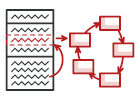
State en Python
State es un patrón de diseño de comportamiento que permite a un objeto cambiar de comportamiento cuando cambia su estado interno.
El patrón extrae comportamientos relacionados con el estado, los coloca dentro de clases de estado separadas y fuerza al objeto original a delegar el trabajo de una instancia de esas clases, en lugar de actuar por su cuenta.
Complejidad:
Popularidad:
Ejemplos de uso: El patrón State se utiliza habitualmente en Python para convertir las enormes máquinas de estados basadas en switch, en objetos.
Identificación: El patrón State se puede reconocer por métodos que cambian su comportamiento dependiendo del estado del objeto, controlado externamente.
Ejemplo conceptual
Este ejemplo ilustra la estructura del patrón de diseño State. Se centra en responder las siguientes preguntas:
- ¿De qué clases se compone?
- ¿Qué papeles juegan esas clases?
- ¿De qué forma se relacionan los elementos del patrón?
main.py: Ejemplo conceptual
from __future__ import annotations
from abc import ABC, abstractmethod
class Context:
"""
The Context defines the interface of interest to clients. It also maintains
a reference to an instance of a State subclass, which represents the current
state of the Context.
"""
_state = None
"""
A reference to the current state of the Context.
"""
def __init__(self, state: State) -> None:
self.transition_to(state)
def transition_to(self, state: State):
"""
The Context allows changing the State object at runtime.
"""
print(f"Context: Transition to {type(state).__name__}")
self._state = state
self._state.context = self
"""
The Context delegates part of its behavior to the current State object.
"""
def request1(self):
self._state.handle1()
def request2(self):
self._state.handle2()
class State(ABC):
"""
The base State class declares methods that all Concrete State should
implement and also provides a backreference to the Context object,
associated with the State. This backreference can be used by States to
transition the Context to another State.
"""
@property
def context(self) -> Context:
return self._context
@context.setter
def context(self, context: Context) -> None:
self._context = context
@abstractmethod
def handle1(self) -> None:
pass
@abstractmethod
def handle2(self) -> None:
pass
"""
Concrete States implement various behaviors, associated with a state of the
Context.
"""
class ConcreteStateA(State):
def handle1(self) -> None:
print("ConcreteStateA handles request1.")
print("ConcreteStateA wants to change the state of the context.")
self.context.transition_to(ConcreteStateB())
def handle2(self) -> None:
print("ConcreteStateA handles request2.")
class ConcreteStateB(State):
def handle1(self) -> None:
print("ConcreteStateB handles request1.")
def handle2(self) -> None:
print("ConcreteStateB handles request2.")
print("ConcreteStateB wants to change the state of the context.")
self.context.transition_to(ConcreteStateA())
if __name__ == "__main__":
# The client code.
context = Context(ConcreteStateA())
context.request1()
context.request2()
Output.txt: Resultado de la ejecución
Context: Transition to ConcreteStateA
ConcreteStateA handles request1.
ConcreteStateA wants to change the state of the context.
Context: Transition to ConcreteStateB
ConcreteStateB handles request2.
ConcreteStateB wants to change the state of the context.
Context: Transition to ConcreteStateA
 LA OFERTA DE INVIERNO ESTÁ AQUÍ!
LA OFERTA DE INVIERNO ESTÁ AQUÍ!
